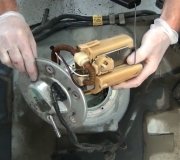An elusive cause that is usually overlooked is a plugged fuel pick-up strainer. That snaps onto the bottom of the in-tank assembly. The most common symptom is fuel pressure drops and the engine stalls when the largest volume of fuel is being pumped, which is during coasting. The engine will typically run better at highway speeds and when accelerating. This has happened to me four times with three vehicles, and it has always occurred after driving about ten to 15 miles, and more often on hot days.
If you installed a replacement pump into the original assembly, you reused the strainer. If you installed a complete new assembly, it should have come with a new strainer on it already.
Once the plug is disconnected on the pump assembly, the contacts are not as tight as they were originally. That can lead to high resistance and heat build-up between the mating terminals. Check those terminals for discoloration and for charring of the connector body.
The way I would approach this is to run the fuel pump with the engine off so you can listen to the pump. Connect a fuel pressure gauge so you can see when the pressure drops. When it does, listen if the pump has slowed down or stopped running. If it has, we'll need to take voltage readings at various places in the circuit to see where the voltage is being lost. Current for the pump comes through two relays and the inertia switch. Those can develop pitted or arced contacts that impede current flow, and that type of problem often gets worse after warming up for a few minutes.
You might want to connect a small battery charger in case this test takes some time. Look for the diagnostic connector under the hood. From the drawings, it appears it is going to be near the battery. Along with that plug, there will be a single separate wire with a terminal on the end. That is the wire that must be grounded to turn on the fuel pump. Use a small jumper wire from that terminal and connect the other end to a paint-free point on the engine or body. The Engine Control relay has to turn on too, which means the ignition switch must be in the "run" position.
If the pump still sounds strong when the pressure drops, suspect the pick-up strainer.
Some Ford models have a history of rubber connecting hoses on the in-tank assembly rotting and leaking inside the tank. The common symptom on car models was stalling when the fuel level got below about half a tank. Those hoses had gas being sucked out by the pump, and the leak allowed air to be sucked in instead of gas. If a pressurized hose has a leak, it will usually cause a loss of fuel pressure all the time, but it still should not be overlooked when the assembly is out for repair.
Images (Click to make bigger)
Thursday, April 4th, 2019 AT 6:23 PM





